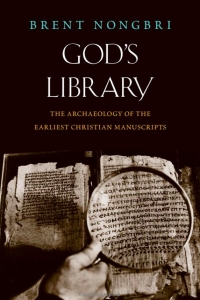A couple years ago, I noted that the Bodleian Library at Oxford had put digital images of several early Christian manuscripts online. Now they have uploaded images of many more manuscripts, and there are several old favorites among them. The most substantial pieces of the Oxyrhynchus codex of Philo of Alexandria, for example, are held at the Bodleian, including a fragment that preserves a parchment stay and binding thread:

(Sidenote: I’ve written a bit about the excavation of the different parts of this codex here, and there has been some interesting recent work on the copyists of the codex by Sean A. Adams in a Festschrift for James Royse, who of course wrote the essential treatment of this codex in a 1980 article.)
As far as I can see, there are about 100 other Oxyrhynchus pieces among the newly digitized materials, including some new and much-improved images of P.Oxy. 1.1, the Gospel of Thomas:

In addition to the Oxyrhynchus papyri, there are now images of other important papyri in the Bodleian, like this fragment from the Psalms that is generally thought to be one of the earliest surviving codices:

It’s great to see these excellent images made more widely available. Thanks once again to our colleagues at the Bodleian Library for making it happen.


I’m happy to report that these links to the Digital Bodleian have already been imported into papyri.info, and that the work of adding digital transcriptions of the texts continues.
Fantastic! Thanks for the update.
Very cool! Thank you for this. Can you say a few words on the piece of wood (?) in the image of the Philo codex?
Do you mean the brown rectangle? That is a stay or guard. They can be leather or parchment (this one looks like parchment), and they are placed in the center of the quire between the thread and the papyrus so that the thread doesn’t tear through the papyrus. I talk about them a bit here: https://earlyhistoryofthecodex.com/2022/07/05/making-a-model-of-p46-part-2-missing-stays/